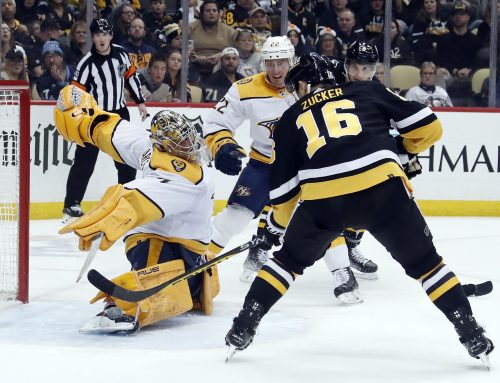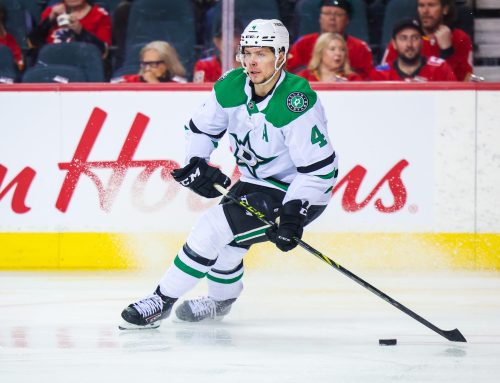
There weren’t any “hockey trades” during this year’s NHL draft weekend. Every trade was either focused around pure draft pick swaps, or salary cap dumps. The draft pick swaps happen every year, but the cap dumps were much bigger and bolder than we have seen in years past. There were three main deals that I want to go over, and then discuss how the thinking behind these trades should be applied to our fantasy teams.
****
Trade #1
To Toronto: 2020 Sixth round pick
To Carolina: Patrick Marleau (AAV – $6,250,000), 2020 first round pick, 2020 seventh round pick
Our first trade involved a first-round pick lumped together with an unaffordable salary in order for one team to clear cap space. On Toronto’s end of the deal, they can part with a first-round pick to make this happen for two reasons. First off, they know they will be a playoff team (and possible Stanley Cup contender) for years to come, so the first-round pick will not be in the top 20 selections, reducing its value. Second, the cap space freed up was not done so willy-nilly, it was done to create room for Mitch Marner. The usage of cap space to upgrade from Marleau’s cost vs talent to Marner’s, was worth a late first round pick who wouldn’t see NHL ice likely for another three years.
On the Carolina side, they had cap space to spare, would be missing veteran leadership if Justin Williams retires, and were subsequently able to ship out Calvin DeHaan’s cap hit (AAV – $4,550,000) at no impactful cost to the team. The Hurricanes filled a need, added a first-round pick, and on the whole, added less than $2 million in salary.
Two different teams in two different places, both coming out on the positive end of the deal.
****
Trade #2
To Nashville: Steven Santini (AAV – $1,416,666), Jeremy Davies, 2019 second round pick, 2020 second round pick
To New Jersey: P.K. Subban (AAV – $9,000,000)
Unlike Toronto, Nashville wasn’t strapped for cash to re-sign their own players this summer, but they did see an opportunity to re-allocate their cap space. Subban’s $9 million cap hit was expendable with the emergence of Dante Fabbro on defence, and a greater need for scoring up front (specifically on the power play). What Nashville can do here is use 90 percent of the savings from parting with Subban’s contract, to bring in a free agent such as Matt Duchene. In doing so, they have a star player going out, a star player coming in, close to neutral salary, and get the secondary pieces from New Jersey as a bonus. If Duchene does not sign, then at least they will have the flexibility to pursue other options.
On the Devils’ side of things, they filled a massive hole in their lineup by only parting with small pieces, as well as indicating to Taylor Hall that the team is headed in the right direction, and he should strongly consider re-signing with them. Weaponizing cap space is the best way to acquire top-end talent without giving up much in return.
****
Trade #3
To Vancouver: J.T. Miller (AAV – $5,250,000)
To Tampa Bay: Marek Mazanec, 2019 third round pick, 2020 first round pick
Tampa Bay had to clear cap space in order to be able to sign Brayden Point to a contract (or at least be ready to match an offer sheet). One of the depth forwards was going to go, and it seems that Tampa found Miller was going to net them the best return. The return (including a possible high first-round pick), was fair for the talent and contract Miller has, but when the situation is taken into account, it looks like Tampa got away with a bit of a robbery here. While the other two trades above involved giving up talent for nothing, or even trading futures with the salary just to get rid of it, the Lightning continue to show why they are the current model franchise of the league.
From the Vancouver perspective, they have to look at turning the corner into a playoff team at some point, meaning one would imagine they aren’t done dealing. Paying a future first-round pick for a player in his mid-20s, on a value contract, who can play in a team’s top-six, is a good deal for any team. The Canucks weren’t able to weaponize their cap space like the Devils did, but the deal certainly helps them ice a more competitive team in the short term.
****
Bonus Analysis
Roberto Luongo Retires
With Roberto Luongo announcing his retirement from the NHL today, the #Panthers and #Canucks will both incur a recapture penalty in the next 3 seasons:#Panthers: $1,094,128 per season#Canucks: $3,033,206 per seasonhttps://t.co/i1qFrgvKbv pic.twitter.com/eiHOl0a83v
— CapFriendly (@CapFriendly) June 26, 2019
As you can see above, one of the greatest goalies to play the game retired yesterday. He leaves third on the all-time wins list, ninth in shutouts, second in games played, and with a career GAA and save percentage of 2.52 and 0.919 respectively. He was also a six-time all-star, and a two-time Olympic gold medalist. Unfortunately, he finishes his playing career without his name on the Stanley Cup.
This is a Capped article though, and this retirement has more of a cap impact than most due to the cap recapture penalty. Long story short, that means that the Vancouver Canucks and Florida Panthers took advantage of a net salary cap benefit due to the structuring of Roberto Luongo’s contract, and now have to make up the difference over the three years that were remaining on his contract at the time of retirement. Again, in the tweet shown above, we see Vancouver and Florida are hit with salary cap penalties for the next three years. Three million (or less in Florida’s case) isn’t an insurmountable amount to deal with, but it does hurt, especially for two teams that have evidently been spending the offseason to this point in an effort to push for the playoffs next season.
In Florida’s case, this does hurt their wiggle room in the pursuit of free agents Artemi Panarin and Sergei Bobrovsky, but it does make things simpler as they won’t need to deal with LTIR, or parting with Luongo’s contract in another manner. For Vancouver, yes, the $3 million penalty hurts, but maybe this is the best-case scenario, as it could have been over $8 million if Luongo had officially announced his retirement two years from now.
All the best in retirement to the future Hall-of-Famer. I hope he gets his Cup by staying on with a team (possibly the Panthers), whether it be as a scout, an advisor, or even a social media manager.
****
Fantasy League Lessons
- Weaponize cap space when possible: If you have cap space free, use it to upgrade the top end of your roster, especially targeting teams who have to get rid of a top player (like P.K. Subban) to make the money work.
-
If you are in a league that restricts drops, taking on salary/contract dumps can be a great way to boost the farm/future. Avoid taking on the
completely uselessMilan Lucic contracts though, and instead target someone like Patrick Marleau that can bring something to your team. In fantasy leagues, maybe that “something” is a stat you’re lacking such as faceoff wins, blocks, or penalty minutes. - Don’t pigeonhole yourself into having to sell off one specific player. Like the Lightning did, shop around your range of players like the Yanni Gourdes, J.T. Millers, Tyler Johnsons, and Ondrej Palats, and be patient waiting for the right deal. Bubble teams do get desperate to shake things up sometimes, and these are the perfect players to sell in those cases.
- Be aware of league rules, and plan ahead for worst case scenarios. Worst case, you’re prepared. Best case, you’re pleasantly surprised and have extra cap space to play with.
****
All salary info courtesy of capfriendly, all statistics are pulled from FrozenTools.
You can find me on Twitter @alexdmaclean.
****
Previous Capped articles:





 FLA
FLA CHI
CHI NYR
NYR PIT
PIT L.A
L.A COL
COL CAR
CAR OTT
OTT TOR
TOR T.B
T.B
 MIN
MIN NYI
NYI BOS
BOS S.J
S.J
